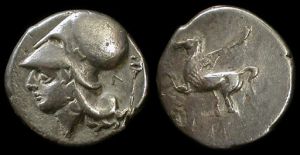Embassy of Greece in London
Home  About Us
About Us  Embassy of Greece in London
Embassy of Greece in London  News
News  Numismatic museum exhibition 'Fire and Coin - Archaelogy and Fire'
Numismatic museum exhibition 'Fire and Coin - Archaelogy and Fire'
 About Us
About Us  Embassy of Greece in London
Embassy of Greece in London  News
News  Numismatic museum exhibition 'Fire and Coin - Archaelogy and Fire'
Numismatic museum exhibition 'Fire and Coin - Archaelogy and Fire'
Numismatic museum exhibition 'Fire and Coin - Archaelogy and Fire'

A period exhibition on "Fire and Currency - Archaeology and Fire" is running at the National Numismatic Museum of Athens through January 10, 2013, focusing on the dual nature of fire, which on the one hand inspires and creates and on the other hand causes awe and destruction,
Organized by the Museum in Collaboration with Ephoria of Underwater Antiquities, the exhibition features works on loan from the Archaeological Museums of Argos and Thebes and from the numismatic collections of the Bank of Greece (BoG) and Alpha Bank, and is taking place in the context of the nationwide action Environment and Culture 2012 "Glowing Fire Stories".
The exhibition is organized in two parts. The first part, titled "Fire and Currency", displays coins and medals depicting fire and its related symbols, such as lightning bolts. torches, ritual fires, altars, volcanoes, a rare depiction on coin of the Lighthouse (Pharos) of Alexandria (one of the original Seven Wonders of the Ancient World, was a tower built between 280 to 247 BC on the island of Pharos at Alexandria, Egypt for the purpose of guiding mariners into the port of Alexandria with the light shed by fire), as well as mythical gods such as Hephaestus and mythological figures such as Talos, the giant that protected Crete.
Also on display is the medal of the first Modern Olympic Games held in Athens in 1896, depicting a sacred phoenix, the mythical bird that is reborn from its ashes, a golden hyperpyron (meaning super-refined, cleansed by fire) minted by the Byzantine Emperor Alexios I Komnenos in 1092 in an effort to drastically rehaul the economy of the Byzantine Empire.
The second part of the exhibition is titled "Archaeology and Fire", and displays sections or full collections of four numismatic "treasures" that suffered immense damage from fire. These are coins which in eras of war, raids, disease and natural disasters were hoarded away in secret hiding-places to protect them and be retrieved at a later time. These include the treasure of the Athens Acropolis, which was destroyed by fire set by the Persians in 480 BC to the Acropolis monuments, two hoards from Delos, which were burned in 88 BC when the troops of Mithridates VI of Pontos attacked the island, and the proto-Byzantine treasure of Chios, which was hoarded for protection on a merchant ship but was later burned in an Arab raid in the 7th century.
The display also includes finds from submarine archaeological exploration by the Ephoria of Underwater Antiquities of shipwrecks, submerged settlements and ports that are related to fire.
SOURCE: ATHENS NEWS AGENCY
Last Updated Tuesday, 23 October 2012


















